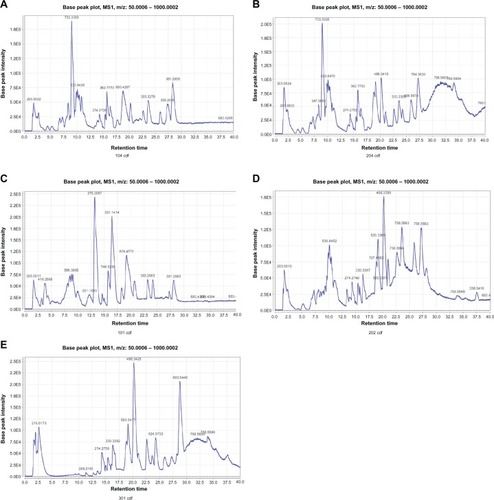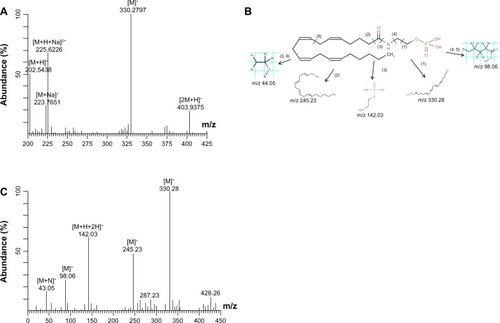Figures & data
Table 1 Demographics and clinical data of the subjects
Figure 1 Base peak intensity chromatograms, using HPLC-MS/Q-TOF-MS, of plasma samples from: the G (−) group before hemodialysis (A), the G (+) group before hemodialysis (B), the G (−) group after hemodialysis (C), the G (+) group after hemodialysis (D), and the control group before hemodialysis (E).
Abbreviations: HPLC, high performance liquid chromatography; MS, mass spectrometry; Q-TOF, quadrupole time-of-flight.

Figure 2 Principal component analysis score scatter plots (A) and orthogonal partial least squares–discriminate analysis score plots (B) based on plasma metabolic profiling of control patients and maintenance hemodialysis (G+, G−) patients before hemodialysis.
Key: 1, G (−) group; 2, G (+) group; 3, control group.

Figure 3 (A) Orthogonal signal correction–partial least squares discriminate analysis score plots of the three groups after hemodialysis. The ellipse shows the 95% confidence region for Hotelling’s T2 statistic for this model. Cumulative fitness (values) and prediction power (value) of this three-component model were 0.915 and 0.952, respectively. 1, G (−) group; 2, G (+) group; 3, control group. (B) Orthogonal partial least squares S-plot based on detected plasma metabolites from the G (−) and G (+) groups.

Figure 4 Identification procedure of the potential biomarker anandamide 0-phosphate. (A) The mass spectrum at the retention time of 7.10 minutes. (B) The MS/MS spectrum of the ion of m/z 225 at 7.10 minutes in the plasma sample. (C) The possible fragmentation mechanism of anandamide 0-phosphate.

Table 2 Comparison of the main biomarkers in glucose and glucose-free dialysis